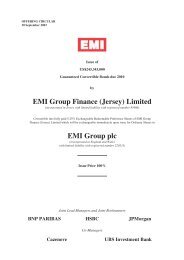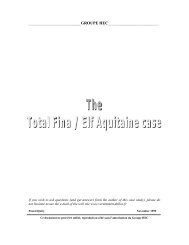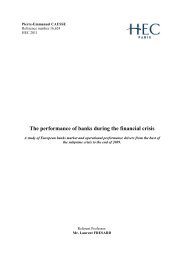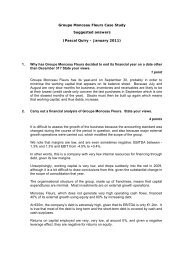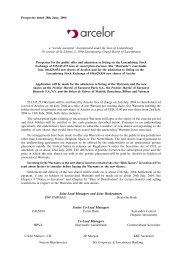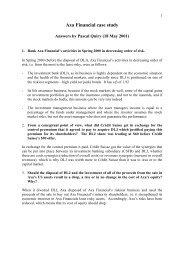Thesis_gd_final_vers.. - Vernimmen
Thesis_gd_final_vers.. - Vernimmen
Thesis_gd_final_vers.. - Vernimmen
Create successful ePaper yourself
Turn your PDF publications into a flip-book with our unique Google optimized e-Paper software.
decline is explained first by the impact of declining profitability coupled to a still rapid asset<br />
growth 6 quarters before the failure occurs and then solely by the impact of net losses (table 4)<br />
when asset growth levels off. We also note that failed banks had a statistically significant more<br />
conservative dividend distribution policy when comparing dividends to total assets. We see two<br />
reasons for that, first as bankruptcy nears the degradation of net income relative to total assets<br />
makes failed banks able to distribute less dividends, second as failed banks have experienced<br />
strong asset growth (Table 9), they may have preferred to use net income generated to increase<br />
their equity and thus have enough regulatory capital to keep expanding their balance sheet without<br />
lowering too much their capital ratio.<br />
Table 8: Univariate tests of equality of the means between failed and safe banks (4/6)<br />
Variable<br />
Quarter<br />
failed<br />
banks<br />
Ratio for<br />
failed banks<br />
Ratio for safe<br />
banks<br />
Difference of<br />
means<br />
t-statistic<br />
equity Q4 2006 174 11.91% 12.02% 0.11% (0.18)<br />
Q2 2007 177 11.28% 12.69% 1.42% (2.01)**<br />
Q2 2008 172 8.79% 12.42% 3.64% (5.46)***<br />
Q1 2009 136 6.68% 11.85% 5.18% (7.94)***<br />
cum_div Q4 2006 174 0.45% 0.59% 0.14% (2.61)***<br />
Q2 2007 177 0.46% 0.59% 0.13% (2.49)**<br />
Q2 2008 172 0.32% 0.57% 0.25% (4.71)***<br />
Q1 2009 136 0.09% 0.45% 0.36% (7.15)***<br />
cash Q4 2006 174 3.07% 4.46% 1.38% (4.40)***<br />
Q2 2007 177 2.80% 4.22% 1.42% ( 4.27)**<br />
Q2 2008 172 3.19% 4.80% 1.62% (4.26)***<br />
Q1 2009 136 7.06% 6.52% -0.54% (-0.97)<br />
dep Q4 2006 174 79.25% 81.16% 1.91% (2.18)**<br />
Q2 2007 177 80.61% 80.28% -0.33% ( -0.32)<br />
Q2 2008 172 80.88% 79.27% -1.62% (-1.61)<br />
Q1 2009 136 86.23% 80.70% -5.53% (-5.40)***<br />
non_core_dep Q4 2006 174 41.65% 33.09% -8.56% (-8.18)***<br />
Q2 2007 177 41.54% 32.58% -8.96% ( -8.49)***<br />
Q2 2008 172 42.36% 33.65% -8.72% (-8.23)***<br />
Q1 2009 136 43.98% 35.60% -8.39% (-6.90)***<br />
ff_purchased Q4 2006 174 1.80% 1.50% -0.30% (-1.22)<br />
Q2 2007 177 1.65% 1.52% -0.13% (-0.54)<br />
Q2 2008 172 1.91% 1.65% -0.26% (-1.04)<br />
Q1 2009 136 0.99% 1.23% 0.25% (1.02)<br />
other_funding Q4 2006 174 6.11% 4.92% -1.20% (-2.69)***<br />
Q2 2007 177 5.68% 4.94% -0.74% ( -1.63)*<br />
Q2 2008 172 8.00% 6.15% -1.85% (-3.61)***<br />
Q1 2009 136 6.91% 5.80% -1.12% (-2.06)**<br />
*, **, *** indicate statistical significance at 10, 5 and 1 percent levels, respectively<br />
2-sided t-test using different variances for the two sub-samples.<br />
Prior to the crisis, failed banks have had significantly lower cash relative to total assets. The results<br />
confirm our hypothesis that failed banks accumulate more cash as they head towards bankruptcy.<br />
Yet this accumulation happens very late when failure may seem unavoidable. We also observe<br />
- 40 -



